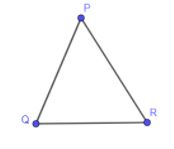
In this question, it is given that if $\angle P\ And \angle Q$ are complementary angles in a triangle PQR, then the measure of angle R is equal to:
(a) ${{45}^{\circ }}$
(b) ${{60}^{\circ }}$
(c) ${{75}^{\circ }}$
(d) ${{90}^{\circ }}$
Answer
555.9k+ views
Hint: We have given that $\angle P\ And \angle Q$ as complementary angles of a triangle PQR then we have to find the measure of angle R. We know that if two angles are complementary, it means that sum of these two angles are ${{90}^{\circ }}$ then sum of $\angle P\ And \angle Q$ is ${{90}^{\circ }}$ and we also know that sum of all the angles of a triangle is ${{180}^{\circ }}$ then if we subtract these two angles $\angle P\And \angle Q$ then we will get the measure of angle R.
Complete step-by-step answer:
In the above problem, we have given a triangle PQR in which $\angle P\And \angle Q$ are complementary angles and we have to find the measurement of angle R.
In the below figure, we have drawn a triangle PQR,

Now, in this triangle we have given $\angle P\And \angle Q$ as complementary and we know that sum of two complementary angles is ${{90}^{\circ }}$ so adding $\angle P\And \angle Q$ and then equating it to ${{90}^{\circ }}$ we get,
$\angle P+\angle Q={{90}^{\circ }}$
We also know that sum of all the angles of a triangle is ${{180}^{\circ }}$ so adding all the angles P, Q and R and equating them to ${{180}^{\circ }}$ we get,
$\angle P+\angle Q+\angle R={{180}^{\circ }}$
Now, substituting the measurement of summation of angles P and Q as ${{90}^{\circ }}$ we get,
${{90}^{\circ }}+\angle R={{180}^{\circ }}$
Subtracting ${{90}^{\circ }}$ on both the sides we get,
$\begin{align}
& \angle R={{180}^{\circ }}-{{90}^{\circ }} \\
& \Rightarrow \angle R={{90}^{\circ }} \\
\end{align}$
Hence, we got the measurement of angle R as ${{90}^{\circ }}$.
So, the correct answer is “Option d”.
Note: The point to be noted here, don’t confuse complementary with supplementary because when two angles are supplementary then their sum is ${{180}^{\circ }}$. You can prevent this confusion in this problem as supplementary angles sum is ${{180}^{\circ }}$ and we know that sum of all the three angles of a triangle is ${{180}^{\circ }}$. Now, if you mistakenly write the sum of two complementary angles as ${{180}^{\circ }}$ then the third angle becomes ${{0}^{\circ }}$ and if the third angle becomes ${{0}^{\circ }}$ in a triangle then the three angles are not making a triangle so here, you will correct yourself and write the complementary angles sum as ${{90}^{\circ }}$ because it will make the third angle non zero and is preventing the condition for three angles to make a triangle.
Complete step-by-step answer:
In the above problem, we have given a triangle PQR in which $\angle P\And \angle Q$ are complementary angles and we have to find the measurement of angle R.
In the below figure, we have drawn a triangle PQR,

Now, in this triangle we have given $\angle P\And \angle Q$ as complementary and we know that sum of two complementary angles is ${{90}^{\circ }}$ so adding $\angle P\And \angle Q$ and then equating it to ${{90}^{\circ }}$ we get,
$\angle P+\angle Q={{90}^{\circ }}$
We also know that sum of all the angles of a triangle is ${{180}^{\circ }}$ so adding all the angles P, Q and R and equating them to ${{180}^{\circ }}$ we get,
$\angle P+\angle Q+\angle R={{180}^{\circ }}$
Now, substituting the measurement of summation of angles P and Q as ${{90}^{\circ }}$ we get,
${{90}^{\circ }}+\angle R={{180}^{\circ }}$
Subtracting ${{90}^{\circ }}$ on both the sides we get,
$\begin{align}
& \angle R={{180}^{\circ }}-{{90}^{\circ }} \\
& \Rightarrow \angle R={{90}^{\circ }} \\
\end{align}$
Hence, we got the measurement of angle R as ${{90}^{\circ }}$.
So, the correct answer is “Option d”.
Note: The point to be noted here, don’t confuse complementary with supplementary because when two angles are supplementary then their sum is ${{180}^{\circ }}$. You can prevent this confusion in this problem as supplementary angles sum is ${{180}^{\circ }}$ and we know that sum of all the three angles of a triangle is ${{180}^{\circ }}$. Now, if you mistakenly write the sum of two complementary angles as ${{180}^{\circ }}$ then the third angle becomes ${{0}^{\circ }}$ and if the third angle becomes ${{0}^{\circ }}$ in a triangle then the three angles are not making a triangle so here, you will correct yourself and write the complementary angles sum as ${{90}^{\circ }}$ because it will make the third angle non zero and is preventing the condition for three angles to make a triangle.
Recently Updated Pages
How do you convert r6sec theta into Cartesian form class 10 maths CBSE

How do you solve dfrac5y3dfracy+72y6+1 and find any class 10 maths CBSE

If sin A+B1 and cos AB1 0circ le left A+B rightle 90circ class 10 maths CBSE

On the number line 10 is to the of zero class 10 maths CBSE

How do you solve 5xge 30 class 10 maths CBSE

In the following sentence supply a verb in agreement class 10 english CBSE

Trending doubts
Write examples of herbivores carnivores and omnivo class 10 biology CBSE

Search and you will find The speed of light is kms class 10 physics CBSE

Fill the blanks with proper collective nouns 1 A of class 10 english CBSE

The speed of revolution of earth in its orbit around class 10 social science CBSE

Difference between mass and weight class 10 physics CBSE

Explain series connections of Resistors and derive class 10 physics CBSE




